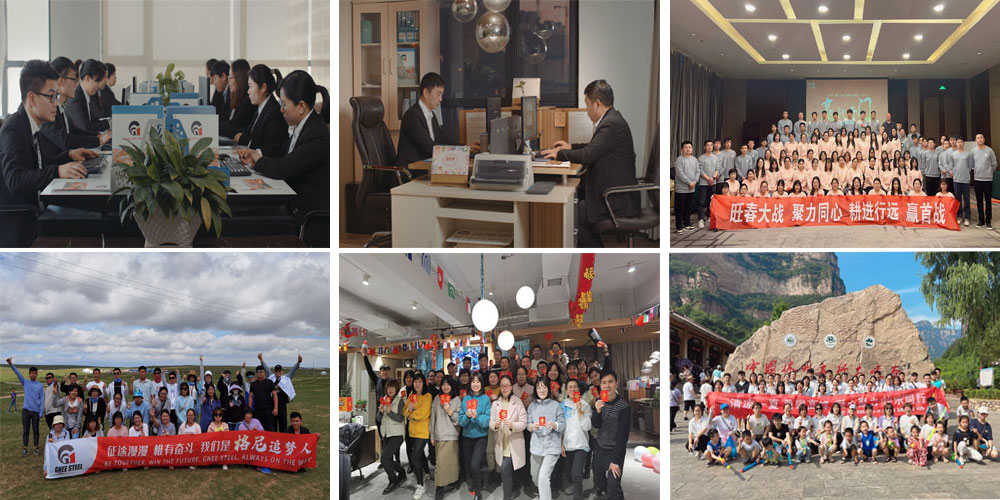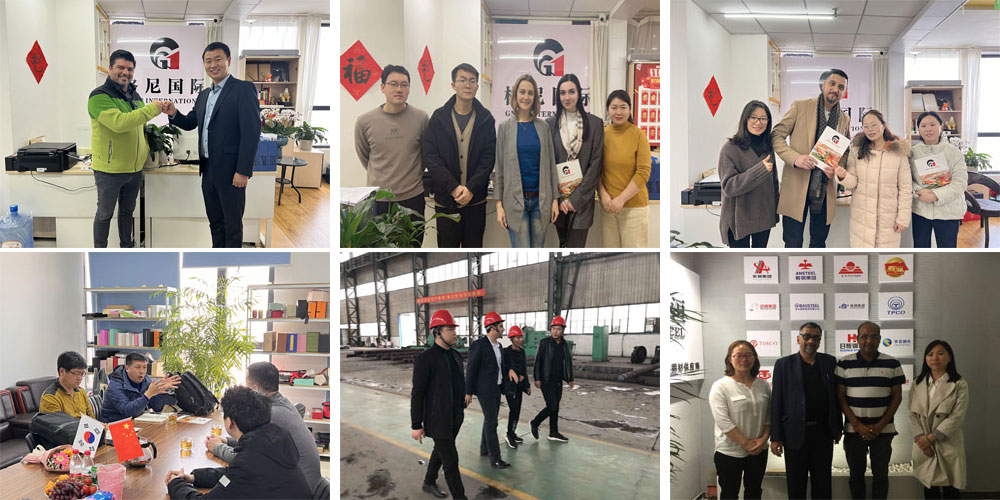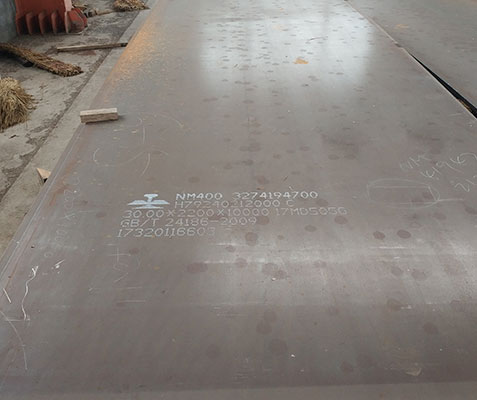
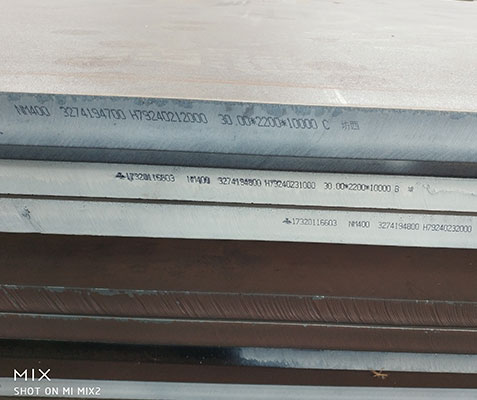
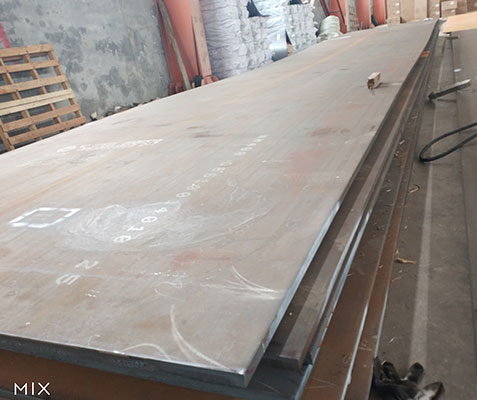
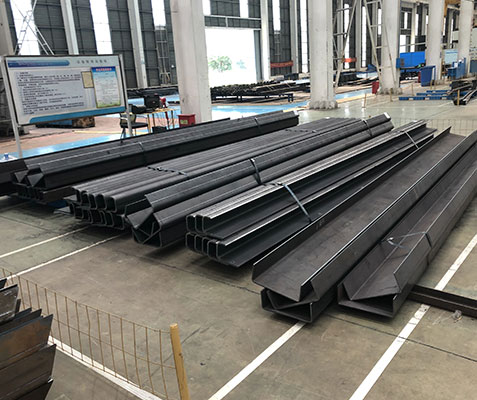




NM400 is high strength wear resistant steel plate. The NM400 has quite high mechanical strength; Its mechanical properties are 3 times to 5 times that of ordinary low alloy steel plates. It can significantly improve the wear resistance of mechanical related parts. Therefore, improve the service life of machinery; The surface hardness of the product usually reaches 360 ~ 450HB. Used for mining and all kinds of construction machinery wear-resistant parts processing and manufacturing applicable structural steel plate.
NM400 is a kind of wear-resistant steel plate. NM – represents wear-resistant use of “resistant” and “grinding” Chinese pinyin first letter 400 is the Brinell hardness value HB value. (The hardness value of 400 is generalized, and the hardness value range of domestic NM400 is 360-420.)
NM400 wear-resistant steel plate is widely used in construction machinery, mining machinery, coal mining machinery, environmental protection machinery, metallurgical machinery and other parts. Excavator, loader, bulldozer bucket board, blade board, side blade board, blade. Crusher lining plate, blade.
The delivery status of wear-resistant steel plate is: quenching and tempering (that is, quenching and tempering)
Thickness: 5mm-120mm(optional).
Width: 500mm-4000mm(optional).
Length: 1000mm-12000mm(optional).
Profiled: According to drawing.
Inspection: Chemical analysis, Metallographic, Mechnical analysis, Ultrasonic testing, Impact testing, Hardness testing, Surface quality and Dimension report.
MOQ: 1pcs.
| Element | C | Si | Mn | P | S | Cr | Mo | Ni | B | CEV | |
| Grade | NM400 | ≤0.25 | ≤0.70 | ≤1.60 | ≤0.025 | ≤0.010 | ≤1.4 | ≤0.50 | ≤1.00 | ≤0.004 |
| Steel Grade | Y.S (MPa) | T.S (MPa) | Elongation A5(%) | Impact Test | Hardness | |
| min | min | min | (°C) | AKV J(min) | HBW | |
| NM360 | 800 | 1000 | 10 | -20 | 30 | 320-400 |
| NM400 | 1000 | 1250 | 10 | -20 | 30 | 360-440 |
| NM450 | 1250 | 1500 | 10 | -20 | 30 | 410-490 |
| NM500 | 1300 | 1700 | 10 | -20 | 30 | 450-540 |
The measured values of steel plate tensile properties Rp0.2, Rm and A50 are provided.
The measured values (AKV) of longitudinal impact of steel plate at 0°C and -20°C are provided.
Hardness is divided into: Rockwell hardness, Brinell hardness, Vickers hardness, Richwell hardness, Shore hardness, Barinell hardness, Nooul hardness, Weinwell hardness. Vickers hardness is expressed by HV, Rockwell hardness can be divided into HRA, HRB, HRC, HRD, Brinell hardness is expressed by Hb [N(KGF /mm2)] (HBSHBW) (refer to GB/T231-1984). It is not a simple physical concept to measure the hardness of steel parts after annealing, normalizing and tempering by Brinell hardness method in production.
It is a comprehensive index of mechanical properties such as elasticity, plasticity, strength and toughness of materials. Hardness test according to the different test methods can be divided into static pressure method (such as Brinell hardness, Rockwell hardness, Vickers hardness, etc.), scratch method (such as Mohr hardness), bounce method (such as Shore hardness) and micro hardness, high temperature hardness and other methods.
| Order | Sample Number | Sampling Method | Test Method | |
| 1 | Stretch | 1 | GB/T2975-82 | GB228/T-2002 |
| 2 |
Shock |
3 | GB/T2975-82 | GB/T229-1994 |
| 3 | Hardness | 1 | GB/T2975-82 | GB231-84 |
Hardness test: mill off 1.0-2.5mm on the surface of the steel plate, and then carry out hardness test on the surface. It is generally recommended that you mill out 2.0mm for hardness test.
Cutting crack: steel plate cutting crack is similar to hydrogen induced crack during welding. If steel plate cutting crack occurs, it will appear within 48 hours to a few weeks after cutting.Therefore, the cutting crack belongs to the delayed crack, the thickness and hardness of the steel plate is greater, the greater the cutting crack.
Preheat cutting: the most effective way to prevent steel plate cutting crack is to preheat before cutting.Before flame cutting, the steel plate is usually preheated, and its preheating temperature mainly depends on the quality grade and thickness of the steel plate, as shown in Table 2.Preheating method can be flame gun, electronic heating pad for heating, can also use a heating furnace heating.In order to determine the preheating effect of the steel plate, the required temperature should be tested at the adding hot spot.
Note: preheating special attention, to make the plate interface uniformly heated, so as not to contact the heat source of the area of local overheating phenomenon.
Low speed cutting: Another way to avoid cutting cracks is to reduce the cutting speed.If you cannot preheat the whole plate, you can use local preheating method instead.Using low speed cutting method to prevent cutting crack, its reliability is not as good as preheating.We suggest preheating the cutting belt with flame gun cavitation several times before cutting, and the preheating temperature is appropriate to reach about 100°C.The maximum cutting speed depends on the steel plate grade and thickness
Special note: the combination of preheating and low speed flame cutting methods can further reduce the occurrence probability of cutting cracks.
Slow cooling requirements after cutting: whether the cutting is not preheated or not, slow cooling of the steel plate after cutting will effectively reduce the risk of cutting crack.If it is stacked with warm and dry after cutting, it can be covered with heat insulation blanket, and slow cooling can be realized. Slow cooling requires cooling to room temperature.
Heating requirements after cutting: for the cutting of wear-resistant steel plate, heating (low temperature tempering) is taken immediately after cutting, which is also an effective method and measure to prevent cutting cracks.Cutting thickness of steel plate through low temperature tempering treatment, can effectively eliminate the cutting stress (low temperature tempering process;Moisturizing time: 5min/mm)
For the method of heating after cutting, burning gun, electronic heating blanket and mourning furnace are also used for heating after cutting.
The anti-softening properties of steel mainly depend on its chemical composition, microstructure and processing method.For thermally cut parts, the smaller the part, the greater the risk of softening the whole part.If the temperature of the steel plate exceeds 200-250°C, the hardness of the steel plate will decrease.
Cutting method: when the steel plate is cutting small parts, the heat supplied by the welding torch and preheating will gather in the workpiece.The smaller the cutting size, the size of the cutting workpiece must not be less than 200mm, otherwise the workpiece will have the risk of softening.The best way to eliminate the risk of softening is cold cutting, such as water jet cutting.If thermal cutting must be used, plasma or laser cutting is a limited choice.This is because flame cutting provides more heat to the workpiece, thus raising the temperature of the workpiece.
Underwater cutting method: an effective method to limit and reduce the scope of the softening zone, using water to the lenga steel plate and the cutting surface during the cutting process.Therefore, the steel plate can be cut in water, or it can be cut by spraying water to the cutting surface.Plasma or flame cutting is optional for underwater cutting.Underwater cutting has the following characteristics:
Table of comparison between NM400 wear-resisting steel plate and imported steel
| WYJ/WJX | JFE | SSAB | DILLIDUR | SUMIHARD |
| WNM400 | JFE-EH400 | HARDOX400 | 400V | K400 |
NM400 wear-resisting steel plate domestic brand comparison table
| WYJ/WJX | WISCO | HARD | Q/XGJ | JX62 |
| WNM400 | NM400 | HARDOX400 | NM400 | NM400 |
More than 5000 tons of NM400 steel plates are used for excavator, loader, bulldozer bucket plate, blade plate, side blade plate, blade plate, crusher liner plate and blade construction projects in engineering machinery, mining machinery, coal mining machinery, environmental protection machinery, metallurgical machinery and other manufacturing enterprises.

